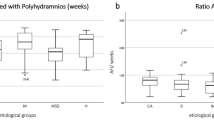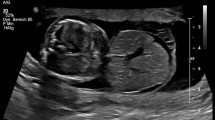Abstract
Objective:
The aim of this study was to examine fetal and neonatal outcomes in the setting of nuchal translucency (NT) ⩾3 mm at routine first-trimester screening.
Study Design:
A nested case-series study within a retrospective cohort of women screened for Down syndrome at 11–14 weeks of gestation. Crown-rump length, NT values and additional anomalies at first and early second trimesters were recorded. Follow-up information was obtained by a review of medical records and self-report from patients. Adverse outcomes included fetal death and termination of pregnancy due to structural or chromosomal anomalies.
Result:
A total of 1930 pregnant women were screened between 11 and 14 weeks of gestation. The prevalence of increased fetal NT (⩾3 mm) was 1.4% (n=27). Among these, 12 showed increased fetal NT as an isolated finding. In this group, 2 women experienced fetal demise (16%) and 10 delivered healthy babies. In the group with additional abnormalities (n=15), 9 (60%) were found to have chromosomal abnormalities, all of which were terminated. For all cases with increased fetal NT, total incidence of adverse outcome was 62%.
Conclusion:
At first-trimester ultrasonography, a fetal NT ⩾3 mm was associated with a high incidence of chromosomal abnormalities in the presence of associated abnormalities. For cases with the increased fetal NT at first-trimester fetal assessment and follow-up is necessary to detect possible adverse outcomes.
This is a preview of subscription content, access via your institution
Access options
Subscribe to this journal
Receive 12 print issues and online access
$259.00 per year
only $21.58 per issue
Buy this article
- Purchase on Springer Link
- Instant access to full article PDF
Prices may be subject to local taxes which are calculated during checkout

Similar content being viewed by others
References
Pandya PP, Santiago C, Snijders RJ, Nicolaides KH . First trimester fetal nuchal translucency. Curr Opin Obstet Gynecol 1995; 7: 95–102.
Comstock C, Malone F, Ball RH, Nyberg DA, Saade GR, Berkowitz RL et al. Is there a nuchal translucency millimeter measurement above which there is no added benefit from first trimester serum screening? Am J Obstet Gynecol 2006; 195: 843–847.
Nicolaides KH, Wegrzyn P . Increased nuchal translucency with normal karyotype. Ginekol Pol 2005; 76: 593–601.
Pandya PP, Kondylios A, Hilbert L, Snijders RJ, Nicolaides KH . Chromosomal defects and outcome in 1015 fetuses with increased nuchal translucency. Ultrasound Obstet Gynecol 1995; 5: 15–19.
Cha’ban FK, Van Splunder P, Los FJ, Wladimiroff JW . Fetal outcome in nuchal translucency with emphasis on normal karyotype. Prenat Diagn 1996; 16: 537–541.
Bilardo CM, Pajkrt E, de Graaf I, Mol BW, Bleker OP . Outcomes of fetuses with enlarged nuchal translucency and normal karyotype. Ultrasound Obstet Gynecol 1998; 11: 401–406.
Cheng CC, Bahado-Singh RO, Chen SC, Tsai MS . Pregnancy outcomes with increased nuchal translucency after routine Down syndrome screening. Int J Gynaecol Obstet 2004; 84: 5–9.
Weisz B, Pandya PP, David AL, Huttly W, Jones P, Rodeck CH . Ultrasound findings after screening for Down syndrome using the integrated test. Obstet Gynecol 2007; 109: 1046–1052.
Nicolaides KH, Azar G, Byrne D, Mansur C, Marks K . Fetal nuchal translucency: ultrasound screening for chromosomal defects in first trimester of pregnancy. BMJ 1992; 304: 867–869.
Malone FD, Canick JA, Ball RH, Nyberg DA, Comstock CH, Bukowski R et al. First-trimester or second-trimester screening, or both, for Down's syndrome. N Engl J Med 2005; 353: 2001–2011.
Hyett J, Moscoso G, Papapanagiotou G, Perdu M, Nicolaides KH . Abnormalities of the heart and great arteries in chromosomally normal fetuses with increased nuchal translucency thickness at 11–13 weeks of gestation. Ultrasound Obstet Gynecol 1996; 7: 245–250.
Rizzo G, Muscatello A, Angelini E, Capponi A . Abnormal cardiac function in fetuses with increased nuchal translucency. Ultrasound Obstet Gynecol 2003; 21: 539–542.
Mavrides E, Cobian-Sanchez F, Tekay A, Moscoso G, Campbell S, Thilaganathan B et al. Limitations of using first trimester nuchal translucency measurements in routine screening for major congenital heart defects. Ultrasound Obstet Gynecol 2001; 17: 106–110.
Senat MV, De Keersmaecker B, Audibert F, Montcharmont G, Frydman R, Ville Y . Pregnancy outcome in fetuses with increased nuchal translucency and normal karyotype. Prenat Diagn 2002; 22: 345–349.
Nyberg DA, Luthy DA, Resta RG, Nyberg BC, Williams MA . Age-adjusted ultrasound risk assessment for fetal Down's syndrome during the second trimester: description of the method and analysis of 142 cases. Ultrasound Obstet Gynecol 1998; 12: 8–14.
Brown DL, Roberts DJ, Miller WA . Left ventricular echogenic focus in the fetal heart: pathologic correlation. J Ultrasound Med 1994; 13: 613–616.
Roberts DJ, Genest D . Cardiac histologic pathology characteristic of trisomies 13 and 21. Hum Pathol 1992; 23: 1130–1140.
Prefumo F, Presti F, Thilaganathan B, Carvalho JS . Association between increased nuchal translucency and second trimester cardiac echogenic foci. Obstet Gynecol 2003; 101: 899–904.
Shah YG, Eckl CJ, Stinson SK, Woods Jr JR . Biparietal diameter/femur length ratio, cephalic index, and femur length measurements: not reliable screening techniques for Down syndrome. Obstet Gynecol 1990; 75: 186–188.
Hyett J, Noble P, Sebire NJ, Snijders R, Nicolaides KH . Lethal congenital arthrogryposis presents with increased nuchal translucency at 10–14 weeks of gestation. Ultrasound Obstet Gynecol 1997; 9: 310–313.
Malone FD, Ball RH, Nyberg DA, Comstock CH, Saade GR, Berkowitz RL et al. First-trimester septated cystic hygroma: prevalence, natural history and pediatric outcome. Obstet Gynecol 2005; 106: 288–294.
Molina FS, Avgidou K, Kagan KO, Poggi S, Nicolaides KH . Cystic hygromas, nuchal edema, and nuchal translucency at 11–14 weeks of gestation. Obstet Gynecol 2006; 107: 678–683.
Cicero S, Sonek JD, McKenna DS, Croom CS, Johnson L, Nicolaides KH . Nasal bone hypoplasia in trisomy 21 at 15–22 weeks’ gestation. Ultrasound Obstet Gynecol 2003; 21: 15–18.
Author information
Authors and Affiliations
Corresponding author
Rights and permissions
About this article
Cite this article
Dane, B., Dane, C., Cetin, A. et al. Pregnancy outcome in fetuses with increased nuchal translucency. J Perinatol 28, 400–404 (2008). https://doi.org/10.1038/jp.2008.14
Received:
Revised:
Accepted:
Published:
Issue Date:
DOI: https://doi.org/10.1038/jp.2008.14



